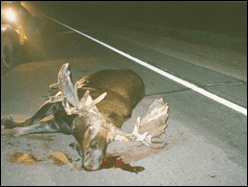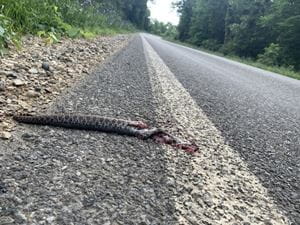The web Browser you are currently using is unsupported, and some features of this site may not work as intended. Please update to a modern browser such as Chrome, Firefox or Edge to experience all features Michigan.gov has to offer.
MDOT submits funding request to study wildlife crossing hotspots
September 19, 2024
SAGINAW, Mich. - "Drive safe and watch for deer." Likely the most common Midwest goodbye but a new effort by the Michigan Department of Transportation (MDOT) could make a dent in the number of vehicle/wildlife crashes across the state. MDOT, working in collaboration with the Michigan Department of Natural Resources (MDNR), recently submitted their first grant proposal to secure funding that will identify key wildlife crossings posing a risk for motorist safety.
The grant application aims to secure funding from the United State Department of Transportation's (USDOT) Wildlife Crossings Pilot Program (WCPP). In 2023, the USDOT awarded $110 million in funding for 17 states and 19 total wildlife crossings. Awards included $24.4 million for Wyoming DOT to complete several crossings supporting migratory patterns for mule deer, pronghorn and other species. MDOT is now officially throwing their hat into the funding ring, with an end goal to create mitigation plans to drastically reduce the number of wildlife-vehicle collisions (WVCs), while protecting at-risk species.
MDOT has spent the last four years tracking the number of deer found dead along trunklines, while also relying on UD-10 forms completed by law enforcement to indicate additional locations where WVCs are repetitive. Michigan typically ranks fourth highest in the nation for deer/vehicle crashes, with an average of 55,000 deer/vehicle crashes per year, resulting in $130 million in damages. Michigan also reports crashes with moose, elk, bear, and wild turkeys, and while the number of crashes with other large species is not as high, the risk and damage are detrimental when compared to car/deer collisions. Additional at-risk species can be protected by wildlife crossings as well, including Blanding's turtles, eastern massasauga rattlesnakes, and pine marten.
"This project is a key step in ensuring wildlife have safe passages to reach critical habitats they need to prosper," said Dr. Jared Duquette, human-wildlife interaction specialist with MDNR, and co-author of MDOT's grant application. "Even a small number of mortalities can severely hinder populations of at-risk species."
If awarded, MDOT will share their current data, along with that collected by MDNR and other state departments, with a consultant team tasked with collecting additional WVC data and developing a wildlife hotspot analysis. The analysis will identify the top 20 locations statewide responsible for repetitive WVCs, allowing MDOT to work toward the ultimate goal of providing WVC mitigation and protecting all Michiganders, including the wildlife variety.
MDOT Bay Region Resource Specialist Amanda Novak is responsible for the initial data collection the department started in recent years and spoke about the grant application on this week's Talking Michigan Transportation podcast. "Creating a wildlife mitigation plan to help protect drivers and animals has been a personal goal since before I came to MDOT," Novak said. "I know we can improve safety and protect wildlife at the same time, and ultimately we can do this by implementing animal crossings at existing locations."
Novak is referring to the final step, putting the information the hotspot analysis identifies into action. MDOT intends to retrofit existing structures, like culverts or bridges, to accommodate wildlife looking for a safe path to cross the road. Identifying the most popular spots for crossing will allow MDOT an opportunity to channel wildlife toward a structure that can accommodate them for crossing, like a culvert with little or no standing water underground, or the underside of a bridge spanning a stretch of trunkline. Retrofitting existing structures, while also accounting for hotspot information during future road and bridge maintenance and construction, could help MDOT reduce WVCs without increasing expense building wildlife-only crossings.
MDOT expects to learn more about their grant proposal by early spring. The department is requesting $467,376 of federal WCPP funds and will match with $116,844 of state funding. While MDOT is likely facing stiff competition from neighboring DOTs, Novak is looking forward to USDOT's final decision.
"Thanks to assistance from MDNR, and advice from other DOTs with successful wildlife crossings, I feel confident we submitted a strong proposal," Novak said. "If we're not successful this round, we will regroup, strengthen our application and submit again for round two."

Bull moose struck by vehicle in the Upper Peninsula of Michigan.
Credit: MDNR

Gravid Blanding's turtle struck by a vehicle in southern Michigan.
Credit: Eric McCluskey

Eastern massasauga rattlesnake struck by a vehicle along a state highway in Michigan.
Credit: Jennifer Moore
Media Contact: